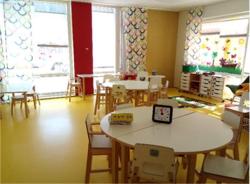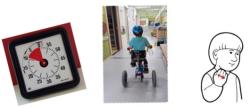Tesoma Daycare Centre integrated group
Keltainen 2 / Auringot
Keltainen 2
tel. 0400 545324
Special needs teacher for early childhood education
040 8064053
The integrated group at Tesoma Daycare Centre, Keltainen 2, is one of seven integrated groups in the western area.
Because an integrated group does not necessarily operate at every child's nearest daycare centre, some of the children come to daycare by taxi. There are 14 children in the Keltainen 2 group, 6 of whom need strong support to learn and grow. They are joined by 8 peer playmates.
The group is staffed by 4 adults, including 2 early childhood education teachers, 1 early childhood education worker and 1 group assistant. A special needs early childhood education teacher is present in the group one morning a week to ensure the rehabilitation of children in need of support.
Staff during the 2022–2023 year
- Early childhood education teacher Jenni
- Early childhood education teacher Anne-Mari
- Early childhood education worker Riina
- Group assistant Mirka
Come along to the Auringot!
In the Keltainen 2 group, strong structure, sign language, pictures and a variety of other aids are used to support learning. On the one hand, the activities are similar to any other group but, on the other hand, they are more structured than usual.
In the group space, there is an illustrated weekly calendar on the wall and a daily schedule, which is almost the same every day.
The daily schedule is always reviewed with the children at the morning circle, after which the children are divided into activities according to the plans. Advance notice of changes to the daily schedule are always given through pictures.
In our group, we work for part of the day in small groups. There may be 1–5 children in a small group, depending on what is being done and how much personal guidance the children need. Planning activities takes into account the fact that children learn best from each other. Small group work and adult resources ensure that children get help exactly where they need it.
However, an adult guides and helps the children by supporting their activity and participation in whatever is being done. Nothing is done on behalf of the child, and it is accepted that whatever is done is done from the child's perspective and that their views are taken into account.
Because the integrated group tends to have children who need more visual support for their language and speech learning, the group may pay more attention than other groups to ensuring that the adult's speech is clear, instructions are brief, examples of speech are given for children to imitate and their expression is supported by positive encouragement.
Staff try to use signs and pictures to support speech at all times of the day. Visual support for communication, choice of games and activity progression is provided in the form of individual pictures or a series of pictures, for example during dressing and eating. Sometimes a communication folder or tablet communication software is also used with individual children to help them learn to say what they want.
We also use a lot of other tools to help the children anticipate and to make daily life smoother.
A variety of activity cushions and toys, weighted blankets and dogs, as well as, for example, the children's own individually demarcated ‘dressing rooms’, are actively used. In order to illustrate the passage of time, we often use TimeTimer. Some children also sometimes have their own personal aids, such as a rollator, bicycle, wheelchair or pressure suit.
Many children are also visited by speech, occupational and physiotherapists for therapy and consultations with the adults in the group. The presence of therapists in the rooms and corridors makes the children's rehabilitation a natural part of everyday life.
See you at the Auringot!
Ryhmässämme toimitaan osa päivästä pienryhmissä. Pienryhmässä saattaa olla lapsia 1-5 sen mukaan mitä tehdään ja kuinka paljon lapset tarvitsevat henkilökohtaista ohjausta. Toiminnan suunnittelussa huomioidaan se, että lapset oppivat parhaiten toisilta lapsilta. Pienryhmätyöskentelyllä ja aikuisresurssilla turvataan se, että lapset saavat juuri siinä kohtaa apua, jossa he sitä tarvitsevat.
Aikuinen ohjaa ja auttaa lasta kuitenkin tukien lapsen omaa aktiivisuutta ja osallistumista toimintaan. Lapsen puolesta ei tehdä ja hyväksytään se, että tekemisestä tulee lapsen näköistä ja hänen näkemyksensä siinä huomioidaan.
Koska integroidussa ryhmässä on yleensä lapsia, jotka tarvitsevat enemmän visuaalista tukea kielen- ja puheenoppimiselleen, ryhmässä kiinnitetään huomiota ehkä muita ryhmiä tarkemmin siihen, että aikuisen puhe on selkeää, ohjeet annetaan lyhyesti, lasten puhetta mallinnetaan ja heidän ilmaisuaan tuetaan positiivisella kannustuksella.
Henkilökunta pyrkii käyttämään päivän kaikissa tilanteissa puheen tukena viittomia ja kuvia. Kuvatukea kommunikoinnille, leikinvalinnalle ja toiminnan etenemiselle annetaan yksittäisinä kuvina tai kuvasarjoina esimerkiksi pukemis- ja ruokailutilanteissa. Välillä yksittäisten lasten kanssa käytetään myös kommunikointikansiota tai tabletin kommunikointiohjelmia, jotta lapsi oppisi itse kertomaan mitä hän haluaa.
Ennakoinnin ja arjen sujuvuuden vuoksi meillä on käytössä paljon myös muita apuvälineitä
Erilaisia aktiivityynyjä ja - leluja, painopeittoja ja –koiria sekä esimerkiksi omia rajattuja pukemistiloja käytetään aktiivisesti. Ajan kulumisen havainnollistamiseen käytämme usein TimeTimeria. Joillain lapsilla on joskus käytössä myös omia henkilökohtaisia apuvälineitä, kuten, rollaattori, pyörä, pyörätuoli ja painepuku.
Päiväkodilla käy myös monen lapsen puhe-, toiminta- ja fysioterapeutit antamassa terapiaa ja konsultoimassa ryhmän aikuisia. Terapeuttien näkyminen tiloissa ja käytävillä tekee lasten kuntoutuksesta luonnollista arkea.
Nähdään Auringoilla!


